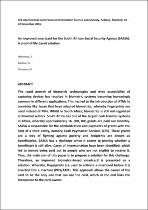 ResearchSpace
ResearchSpace
An improved smartcard for the South African Social Security Agency (SASSA): A proof of life based solution
JavaScript is disabled for your browser. Some features of this site may not work without it.
- ResearchSpace
- →
- Research Publications/Outputs
- →
- Conference Publications
- →
- View Item
| dc.contributor.author |
Mthethwa, Sthembile

|
|
| dc.contributor.author |
Barbour, Graham

|
|
| dc.date.accessioned | 2017-05-17T07:05:52Z | |
| dc.date.available | 2017-05-17T07:05:52Z | |
| dc.date.issued | 2016-12 | |
| dc.identifier.citation | Mthethwa, S. and Barbour, G. 2016. An improved smartcard for the South African Social Security Agency (SASSA): A proof of life based solution. 3rd International Conference on Information Science and Security, Pattaya, Thailand, 19 - 22 December 2016. DOI: 10.1109/ICISSEC.2016.7885842 | en_US |
| dc.identifier.isbn | 978-1-5090-5493-0 | |
| dc.identifier.uri | DOI: 10.1109/ICISSEC.2016.7885842 | |
| dc.identifier.uri | http://ieeexplore.ieee.org/document/7885842/ | |
| dc.identifier.uri | http://hdl.handle.net/10204/9087 | |
| dc.description | 3rd International Conference on Information Science and Security, Pattaya, Thailand, 19 - 22 December 2016. Due to copyright restrictions, the attached PDF file only contains the abstract of the full text item. For access to the full text item, please consult the publisher's website. | en_US |
| dc.description.abstract | The rapid growth of biometric technologies and wide accessibility of capturing devices has resulted in biometric systems becoming increasingly common in different applications. This has led to the introduction of ATMs in countries like Japan that have adapted biometrics, whereby fingerprints are used instead of PINs. Whilst in South Africa, biometrics is still not regulated in financial sectors. South Africa has one of the largest cash transfer systems in Africa, whereby approximately 16, 900, 000 grants are paid out monthly. SASSA is responsible for the administration and payments of grants with the help of a third entity, namely; Cash Paymaster Services (CPS). These grants are a way of fighting against poverty and recipients are known as beneficiaries. SASSA has a challenge when it comes to proving whether a beneficiary is still alive. Cases of impersonation have been identified, which led to money being paid out to people who are not eligible to receive it. Thus, the main aim of this paper is to propose a solution for this challenge. Therefore, an improved biometric-based smartcard is presented as a solution. Whereby, fingerprints are used to activate a smartcard before it is inserted into a machine (POS/ATM). This approach allows the owner of the card to be the only one that can use the card, which at the end links the transaction to the card-owner. | en_US |
| dc.language.iso | en | en_US |
| dc.publisher | IEEE | en_US |
| dc.relation.ispartofseries | Worklist;17657 | |
| dc.subject | South African social security agency | en_US |
| dc.subject | SASSA | en_US |
| dc.subject | Biometric technologies | en_US |
| dc.subject | Fingerprint identification technologies | en_US |
| dc.subject | Smartcards | en_US |
| dc.subject | Proof-of-life | en_US |
| dc.subject | Information security | en_US |
| dc.title | An improved smartcard for the South African Social Security Agency (SASSA): A proof of life based solution | en_US |
| dc.type | Conference Presentation | en_US |
| dc.identifier.apacitation | Mthethwa, S., & Barbour, G. (2016). An improved smartcard for the South African Social Security Agency (SASSA): A proof of life based solution. IEEE. http://hdl.handle.net/10204/9087 | en_ZA |
| dc.identifier.chicagocitation | Mthethwa, Sthembile, and Graham Barbour. "An improved smartcard for the South African Social Security Agency (SASSA): A proof of life based solution." (2016): http://hdl.handle.net/10204/9087 | en_ZA |
| dc.identifier.vancouvercitation | Mthethwa S, Barbour G, An improved smartcard for the South African Social Security Agency (SASSA): A proof of life based solution; IEEE; 2016. http://hdl.handle.net/10204/9087 . | en_ZA |
| dc.identifier.ris | TY - Conference Presentation AU - Mthethwa, Sthembile AU - Barbour, Graham AB - The rapid growth of biometric technologies and wide accessibility of capturing devices has resulted in biometric systems becoming increasingly common in different applications. This has led to the introduction of ATMs in countries like Japan that have adapted biometrics, whereby fingerprints are used instead of PINs. Whilst in South Africa, biometrics is still not regulated in financial sectors. South Africa has one of the largest cash transfer systems in Africa, whereby approximately 16, 900, 000 grants are paid out monthly. SASSA is responsible for the administration and payments of grants with the help of a third entity, namely; Cash Paymaster Services (CPS). These grants are a way of fighting against poverty and recipients are known as beneficiaries. SASSA has a challenge when it comes to proving whether a beneficiary is still alive. Cases of impersonation have been identified, which led to money being paid out to people who are not eligible to receive it. Thus, the main aim of this paper is to propose a solution for this challenge. Therefore, an improved biometric-based smartcard is presented as a solution. Whereby, fingerprints are used to activate a smartcard before it is inserted into a machine (POS/ATM). This approach allows the owner of the card to be the only one that can use the card, which at the end links the transaction to the card-owner. DA - 2016-12 DB - ResearchSpace DP - CSIR KW - South African social security agency KW - SASSA KW - Biometric technologies KW - Fingerprint identification technologies KW - Smartcards KW - Proof-of-life KW - Information security LK - https://researchspace.csir.co.za PY - 2016 SM - 978-1-5090-5493-0 T1 - An improved smartcard for the South African Social Security Agency (SASSA): A proof of life based solution TI - An improved smartcard for the South African Social Security Agency (SASSA): A proof of life based solution UR - http://hdl.handle.net/10204/9087 ER - | en_ZA |





